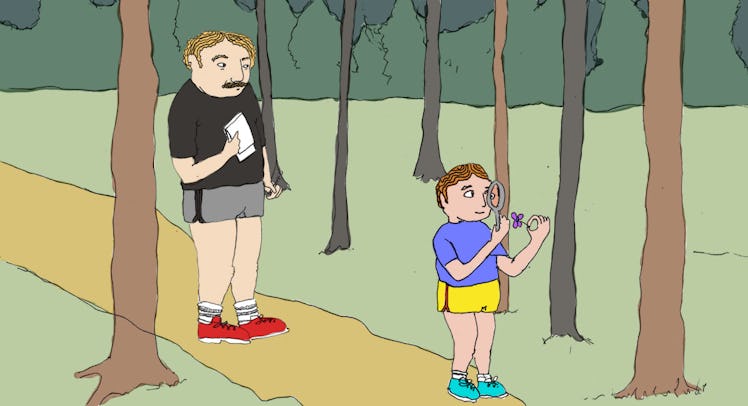‘Nature Hunt’ Turns A Boring Walk Into An Exciting Afternoon Adventure
Even better, it gets them jazzed about going outside and wears them out.

When my daughter first started walking, we spent every afternoon roaming the neighborhood in search of ‘black cat’ or ‘black goat.’ Both animals were real ⏤ the cat a wandering pet, the goat tied up behind a neighbor’s house ⏤ and both served as the perfect motivation to get us out and moving. Where could the black cat be?!? As she got older, however, her interest in them waned and she began to take more notice of her immediate surroundings, whether it was a bug, pine cone, or the shape of the clouds. And thus our new game, ‘Nature Hunt,’ was born.
‘Nature Hunt,’ as one might guess, is an impromptu scavenger hunt in which toddlers are tasked with collecting random items generously left around the yard by Mother Earth. Considering the myriad benefits of outdoor play ⏤ including a reduction in stress, improved levels of Vitamin D, and increased physical and cognitive development ⏤ the game is an easy way to exercise younger toddlers, promote a healthy lifestyle, and foster an early interest in science and the environment. Even better, it involves zero prep and requires little more than a bucket or basket and access to the great outdoors.
Prep Time: None
Entertainment Time: 20 minutesEnergy Expended by Child: Moderate
What You Need:
- A bucket or basket.
- Access to the outdoors.
- Optional: A magnifying glass, tricycle/bicycle with a basket, and a printable scavenger hunt list for which to search.
How to Play:
‘Nature Hunt’ is played much like any other scavenger hunt: There’s a list of objects to find, and it’s up to the child (and parent) to do just that. We play an on-the-fly version of the game which means I do a quick scan of the area, come up with new targets based on what’s in the driveway or yard, and name each one as we go. It’s not uncommon for us to start with a rock or a blade of grass before moving on to a leaf, a berry, a branch, and a small twig. From there it might be a pine cone, flower pedal, piece of bark, and an acorn.
For parents with older kids or who prefer a more structured search, there are plenty of printable nature scavenger hunt lists available online that detail all of the possible objects you might find. Obviously, they can’t predict the unique bugs or plants that might live in your backyard so parents should feel free to add on. Also, a lot of nature scavenger hunt lists include objects for kids to identify but not actually collect ⏤ for example, a bird, a tree, the sun, etc. In ‘Nature Hunt,’ we only check off things we can hold, and they all go into either a bucket or the trunk of my daughter’s tricycle, assuming she decided to drive that day.
We also sometimes bring along a magnifying glass and either take a closer look at each object as we go, or sit down on the driveway at the end of the hunt and examine them all. In both cases, it offers an opportunity to teach them more about the physical world around them. The hunt ends when either all of the items on the list are checked off, you or your child grows bored, or, as is often the case in our house, it’s time for dinner.
Wrap Up:
Getting toddlers outside, or even to want to go outside, isn’t always easy ⏤ but it’s important. Outdoor play is critical to their development and spending time walking around the yard or neighborhood can improve their health, sleep, and cognition ⏤ not to mention wear them out. ‘Nature Hunt’ is a fun way to do all of that, plus get them excited about (and appreciate) nature, kill a half hour after work, and hopefully plant the seeds for a budding hiker, camper, or outdoor enthusiast later in life.

This article was originally published on